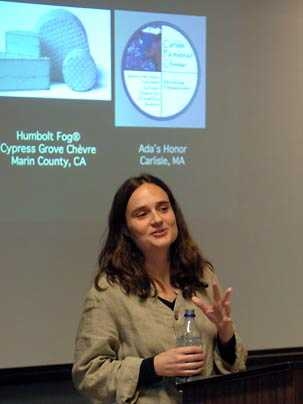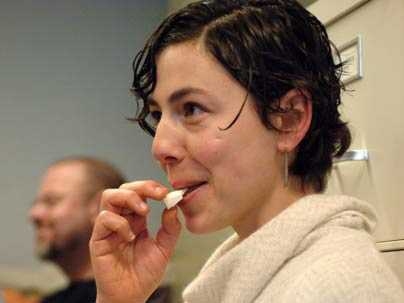Plates of handcrafted cheeses, carefully arranged for identification purposes, were distributed to an eager group of auditors on Dec. 11, in connection with a talk given by Heather Paxson, lecturer in anthropology.
However, Paxson admonished the hungry spectators to hold off eating the five mouth-watering cheeses (four American and one French), as she would cue the moment to taste each cheese during her talk, "Reverse-Engineering Terroir: Crafting Nature-Culture in American Artisanal Cheese Production."
The French term "terroir," "famously untranslatable and, for most Americans, unpronounceable" as Paxson noted, means variously "rural," "regional," "of the earth or locality," or, as she translates it, "the taste of place." It comes from the world of viticulture and describes a specific cluster of vineyards, or even vines, whose wine takes its identity from a combination of natural parameters--grape and soil type, climate and topography--and less quantifiable cultural parameters.
"In certain renditions," Paxson noted, "terroir" can refer also to "the soul of the cultivator, as well as the collective cultural know-how behind agricultural products associated with a place that help to constitute its tradition."
Paxson's interest was piqued by the recent importation of the term "terroir" and how it is being used by artisanal cheese makers in the United States. Her ethnographic fieldwork took her to the 2005 annual meeting of the American Cheese Society (ACS), where "terroir" was the subject of several papers and panels. It also took her into the field(s): She spent two weeks observing and working at Major Farm in Putney, Vt., makers of Vermont Shepherd, "one of America's most distinguished cheeses."
The small-scale producers, who are not so much reviving as inventing their cheese traditions, are anxious to distinguish themselves--legally if possible, but certainly culturally--from the large-scale dairy operations that churn out mass quantities of cheese. The latter are seeking variously to squash, industrialize and co-opt artisanal cheese making--lobbying Congress to outlaw cheese made with unpasteurized milk, for example, and some of the small producers hope that by developing awareness of cheese "terroir" and consequent labeling constraints, they stand a better chance of surviving and even flourishing.
It was one of the participants at the ACS conference who suggested that the artisanal cheese producers are in the process of "reverse-engineering" terroir: "They think backwards from European examples in order to fashion innovative models of terroir, and of cheese, suitable to the nature-culture demands of distinctly American landscapes," said Paxson.
Some approaches that cheesewrights have taken toward terroir take the form of an "ahistorical materialism" on the "nature" end of the spectrum (cue Cheese 1, Humboldt Fog, an aged goat cheese made by Cypress Grove Chèvre of Humboldt County, Calif., and Cheese 2, Ada's Honor, an award-winning mold-ripened chèvre made by Carlisle Farmstead in Massachusetts). The California cheesemakers claim that the particular material conditions on their farms--climate, fodder and so forth--create cheeses that "could not be replicated elsewhere."
Also closer to the "nature" end of the spectrum is the notion of terroir as "New World innovation." This approach is exemplified by David Major of Vermont Shepherd, who found in the Basque country a close geographic analog to his northern New England dairy farm, and chose his materials and methods accordingly; and by Mike Gingrich at Uplands Dairy in Wisconsin, who modeled his "best of show" Pleasant Ridge Reserve (Cheese 3) on the French Beaufort (Cheese 4), and in many people's opinion bested it.
Nearer to the "cultural" side of the nature-culture spectrum, one finds notions of terroir with more political and overtly moral content, as part of the "slow-food" movement and as a facet of environmental awareness. Here we find the Kehlers, two brothers and their wives who make a variety of cheeses (including Cheese 5, Constant Bliss) at Jasper Hill Farm in Vermont's Northern Kingdom.
According to Paxson, the Kehlers "view cheesemaking as [their] personal response to globalization," and they are trying to find ways to make dairying economically and environmentally sustainable in that struggling region. Paxson noted that the Kehlers' approach finds an echo in the State of Vermont's push to increase agritourism as a way of boosting the local economy. Finally, Paxson cited Anne Topham of Fantôme Farm, Wisconsin, who sells her goat cheese exclusively at the Madison Farmer's Market and views it as part of a "network of connections" including her goats, her farm and her customers.
Paxson's interest in cheesemaking may seem far distanced from her previous research, which focused on ideas of motherhood and reproduction in Greece, but as she said in an e-mail, "I am most generally interested in how people craft a sense of themselves as moral persons" through, for instance, food and sex.
She added, "It's interesting just how relevant MIT is turning out to be in my research….[M]any artisan cheesemakers speak of what they're doing in the language of engineering, or they see themselves as, in a sense, hacking the system of food production in this country, bypassing industrial production and figuring out for themselves how to make cheese, say, using plastic bowls from K-Mart punched with holes as cheese molds. Teaching at MIT has given me an appreciation for the ethos of this sort of practice."
A version of this article appeared in MIT Tech Talk on January 10, 2007 (download PDF).







